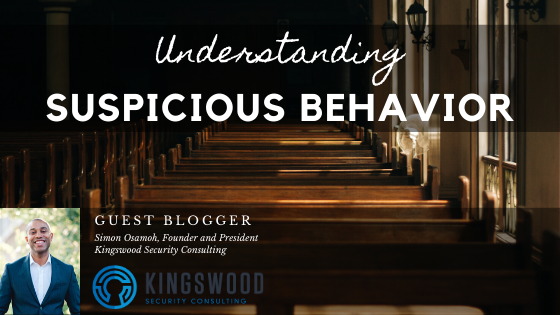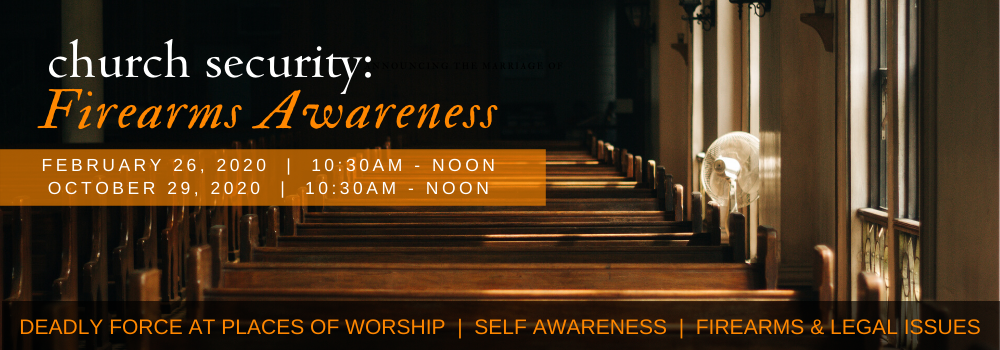Understanding Suspicious Behavior
02.19.2020 Written by: Henningson & Snoxell, Ltd.

Simon Osamoh will be joining Henningson & Snoxell Attorney Virginia Cronin on Wednesday, February 26 to present a free informational class entitled “Church Security: Firearms Awareness”. The seminar runs from 10:30am – noon, and refreshments will be provided. Click here for registration information.
“See something, say something.” It’s a phrase we’ve been inundated with since the tragic events of 9/11 almost two decades ago, but how does one “say something” in a church – a place based on community and fellowship? It’s one of the biggest challenges in security ministry.
Within church culture, there is a very real fear that by raising the alarm or identifying people as “different,” we are not being true to our faith. What is, in fact, true is the opposite: noticing and calling out unusual behavior is often the opportunity to minister to those in need. Unusual behaviors are often indicators of deeper problems. Addressing them early can pave the way for diffusion, avoiding a potentially harmful or criminal situation at your church.
It’s key to remember, however, that when suspicious behavior is displayed, it is not necessarily a precursor for a criminal act. Nor is it an indicator of actual risk. Suspicious behaviors help guide us to recognize risk factors and determine what action to take.
Let’s get back to the original question. How do you identify the “see something” in a church when all people are welcome? At Kingswood Security, we teach four rules that allow ministries to tackle this difficult subject and do so from a position of grace.
Rule 1: Suspicious behavior does not mean that something is wrong.
One Sunday, I walked into a church and saw a large suitcase outside a men’s restroom. It looked out of place and my mind started racing as to all the things it could be. The first things that came to mind were to evacuate the area and call the police, but as I walked into the restroom, I found one of the foreign ministry leaders who was going on a mission trip. He had simply left his suitcase outside. It’s important to remember society is still full of good people. We must be cautious and remember that most of what you feel is suspicious will have a reasonable explanation.
Rule 2: Suspicious behavior starts with the breaking of a social boundary.
In the church, asking people to identify suspicious behavior can have a negative inference attached to it. It can give off the impression that we are not welcoming or are casting judgment on their appearance or social status. I find that when you ask people to look for the breaking of a social boundary, they seem to find it easier to contextualize.
I was at church one Sunday when a woman entered the sanctuary holding a jewelry box. I watched as she stood in front of the pastor, just moments before he was about to start his sermon. Suddenly, without warning, she shouted and threw the jewelry box up in the air. I had noticed her way before she’d thrown the jewelry box – not because of her appearance, but because she’d broken a social boundary by standing in front of the pastor before the sermon. She’d also been holding a jewelry box – something people generally don’t bring to church.
You know your church environment better than anyone! Look for the breaking of social boundaries as this can often lead to suspicious behavior.
Rule 3: Suspicious behavior can be detected through the worship attack cycle
The “worship attack cycle” is a series of behaviors that are often completed before a criminal act takes place. The offender will first identify your church as a target and then start to research your church, often online or through social media posts. The information that they cannot find online will force them to come to your church and conduct surveillance. Now, it’s not like the surveillance you see in the movies, but they need to understand your environment and obstacles they could face before they carry out their criminal act.
They will plan to execute their criminal activities when they feel they know your church environment. They will often practice their plan until they feel confident to take action. You must know the role you play in disrupting the worship attack cycle: during the observation and practice phases is when we will see physical behaviors associated with their action. Understanding these behaviors will help you interrupt the motivated offender by identifying their breaking of social boundaries.
During the “worship attack cycle” watch for the following behaviors:
- People wandering without a purpose
- Asking unusual questions
- Being found in restricted areas
- In the church for an extended period
- Breaking social boundaries
- Inappropriate clothing for the occasion or time of year
- Taking unusual pictures with their phone
- Entering with strange items
- Appearing to have little interest in being involved in your community
- Being out of context for the environment
Remember Rule 1. Suspicious behavior does not mean that something is wrong, but it’s our chance to make sure everyone is okay and to minister to those in need.
Rule 4: Trust your instinct for things that look out of place.
On April 13, 2013, 27-year-old Jeff Bauman was waiting for his girlfriend to cross the Boston Marathon finish line when a bomb went off, resulting in the loss of both of his legs. At the hospital, he told investigators he knew who was responsible for the bombing attack and he was right! He had seen the two brothers at the finish line and knew something didn’t look quite right. They had little to no interest in the race and were faced away from the finish line when everyone else was cheering the contestants on. They were also carrying heavy backpacks and had blank expressions. Bauman said that contextually they just didn’t fit with the other people in the crowd.
We were given instincts to spot danger and keep ourselves safe. We often fear these instincts, especially in a church setting. There is that nagging voice saying, “what if I am wrong?” We can’t live in fear and it’s important to learn through the experiences of others. You know what your instinct is telling you. Trust it and know these instincts came to you for a reason.
Something to Remember!
You may be apprehensive about executing the things discussed above, but being proactive and using these four rules as a guide will help keep you and your ministry safe! Remember, those displaying suspicious behavior could be the very people that you are wanting to serve and need your help the most.

About the author
Simon Osamoh is the President and Founder of Kingswood Security Consulting and the Worship Security Association. While overseeing counterterrorism at Mall of America (Minnesota), he was asked to speak to a large church on security. He then felt a calling to help nonprofit and community organizations. He is the author of the 7 Steps to Protect your Faith Community, former Vice President for the FBI Minneapolis Citizens Academy Alumni Association, former program chair of InfraGard Minnesota and former British detective where his focus was on organized crime. He holds an Individualized B.A focused on British American criminal justice and is a member of Westwood Community Church in Excelsior Minnesota, where he also serves as security advisor.










 Subscribe
Subscribe Subscribe
Subscribe
